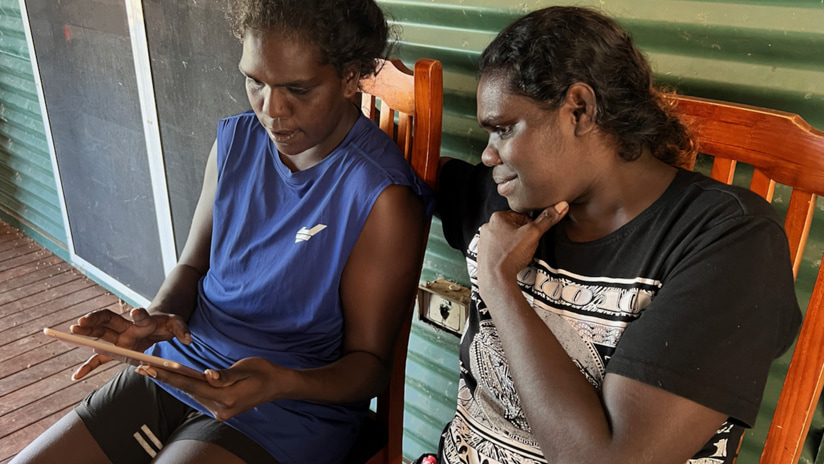Understanding digital inclusion in remote First Nations communities
Research from two important projects has come together to give the public and decision makers our most comprehensive picture yet of the digital inclusion gaps faced by First Nations people in remote communities.

Image: Co-researcher Guruwuy Ganambarr doing survey with resident Alissia Wirrpanda in in Gäṉgaṉ Community, NT
Mapping the Digital Gap for access, affordability and ability
For the first time, data in the Australian Digital Inclusion Index, now in its ninth year, includes data taken from the first Mapping the Digital Gap project report. Both projects are funded by Telstra.
The Australian Digital Inclusion Index (ADII) measures digital inclusion across three dimensions of Access, Affordability and Digital Ability, and across different geographies and social groups. The Mapping the Digital Gap project has captured data from ten remote First Nations communities which have been analysed across the three ADII dimensions allowing the data to be integrated.
What the data tells us
The good news is that digital inclusion at the national level continues to steadily improve. Recent years have seen an increase in Australia’s average Index score from 67.5 (2020), to 71.1 (2021), to 73.2 (2023).
There remains however a considerable digital gap between First Nations and other Australians. The index for First Nations people in 2023 was 65.9 – a full 7.5 points below the national average.
The gap for First Nations people in cities is relatively small at -1.7 compared with other city residents. Perhaps not surprisingly, the digital gap gets more pronounced the more remote the community, rising to -25.3 in very remote communities.
Remoter communities experience wider digital gaps
When it comes to the three barriers to digital inclusion: Access, Affordability and Digital Ability, the results show where some of the priorities may lie.
Digital Ability shows the smallest digital gap with First Nations people at -4.3 below the rest of Australia. This is followed by Affordability at -6.1 then Access at -8.2.
Again, as might be expected, the picture varies depending on the remoteness of the community. Here the differences become stark; in remote and very remote communities for example, Access and Affordability rate at about -38 each behind Australia’s average score for these variables.
Why does all this matter?
Living hundreds of miles from the nearest bank or government office, remote residents often have a greater need for the internet than other Australians. And with the Federal Government planning to continue to modernise and digitise government service delivery under its Data and Digital Government Strategy, the need for reliable, stable, affordable connections in remote communities is only going to keep growing.
The scale of the problem
Dr Daniel Featherstone and Dr Lyndon Ormand-Parker are leading the research team on the Mapping the Digital Gap project, which shows the scale of the problem. Take for example these findings:
- Proportion of remote residents highly excluded from digital services: 45.9% (national average: 9.4%)
- Proportion of respondents using or sharing a mobile device: 84%
- Proportion of respondents who are mobile-only users: 75% (national average: 10.5%)
- Proportion of respondents who sacrifice paying for food/essentials to stay connected: 53.3% (non-First Nations people 19.1%).
In 2023, the Australian Government took several steps to fast-track the National Agreement on Closing the Gap, and specifically its target to deliver “equal levels of digital inclusion as other Australians by 2026”.
First Nations Digital Inclusion Advisory Group
In January 2023, Communications Minister Michelle Rowland set up a First Nations Digital Inclusion Advisory Group, which is co-chaired by Dr Ormand-Parker. The group is supported by an Expert Panel, which includes Dr Featherstone and myself.
In October 2023, the Advisory Group released its own report, "First Nations Digital Inclusion Advisory Group - Initial Report" (PDF, 1.5MB), which proposes a series of practical measures to improve digital inclusion in remote communities.
Our First Nations site
All the ways we're helping First Nations Australians connect to each other from all corners of Country.
What is Telstra doing?
Access
On 26 March 2024, Telstra flipped the switch on a new era for remote connectivity with the launch of its first Low Earth Orbit (LEO) services in conjunction with satellite operator Starlink.
Telstra’s Satellite Home Internet product uses Starlink’s Low Earth Orbit satellite network to provide a world first voice and fixed broadband services on Starlink’s network. The service will deliver additional connectivity options for consumers in regional and remote locations where distance and terrain make it difficult to reach with existing terrestrial networks.
Affordability
Telstra is expanding the rollout of payphones equipped with Free Telstra Wi-Fi, which have now been installed in more than 20 remote communities and in 80 towns with greater than 10% of the population identifying as First Nations residents. Since August 2023, these popular payphones have been installed in another 20 communities – with more planned in 2024 and 2025.
Ability
Telstra’s digital inclusion programs focus on working with community to understand how they want to use digital services. Alongside digital training, Telstra has begun a concerted program to deliver telecommunications advice and support to First Nations customers through its own First Nations call centre, and through community call centres owned by local First Nations organisations and staffed with local people.
First Nations Connect centre
In 2021, Telstra established its First Nations Connect centre in Darwin, which provides advice and support specifically for First Nations communities. Telstra receives an estimated 40,000 calls to the centre each year.
Palm Island and Jumbun call centres
In July 2023, Telstra launched one of two call centres – the first was on Palm Island, a small community off the coast of Townsville. The centre has delivered jobs and training for 20 local operators in a newly constructed retail precinct in the island’s town centre.
The second centre was launched in Jumbun – a small community located halfway between Cairns and Townsville.
Thanks from Telstra
More needs to be done of course, and the data from the Australian Digital Inclusion Index and Mapping the Digital Gap research is helping pinpoint where resources are best placed.
Telstra is very grateful to our partners and the communities who have helped paint the most comprehensive picture of digital inclusion yet.
A collaborative effort
Since 2015, the Australian Digital Inclusion Index has been funded by Telstra and produced in partnership with the ARC Centre of Excellence for Automated Decision-Making and Society at RMIT and Swinburne University of Technology.
The Mapping the Digital Gap project is a four-year research project conducted by the ARC Centre of Excellence for Automated Decision Making and Society in partnership with Telstra. Telstra has committed to extend its funding of MTDG to June 2028.
Learn more
- Digital inclusion score for non-First Nations Australians: 73.4 points out of 100
- Digital inclusion score for First Nations Australians: 65.9
- National digital inclusion gap for First Nations people: 7.5 points (2020: 7.9 points)
- Digital inclusion gap for First Nations people in remote communities: 24.4
- Digital inclusion gap for First Nations people in very remote communities: 25.3
- National digital access score for all Australians in 2023: 72.1
- Digital access score for First Nations Australians: 64 (gap: 8.2)
- National digital affordability score for all Australians: 95.1
- Digital affordability for First Nations Australians: 89.0 (gap: 6.1)
- National digital ability score for all Australians: 65.0
- Digital ability score for First Nations Australians: 60.7 (gap: 4.3)
- Digital inclusion for people in remote communities: 49.0 points out of 100 (gap 24.4)
- Digital inclusion for people in very remote communities: 48.0 (gap 25.3)
- Digital access gap for people in remote communities: 37.6 points
- Digital access gap for people in very remote communities: 38.1 points
- Digital ability gap for people in remote communities: 22.7 points
- Digital ability gap for people in very remote communities: 18.9 points
- Proportion of remote residents highly excluded from digital services: 45.9% (national average: 9.4%)
- Proportion of respondents using or sharing a mobile device: 84%
- Proportion of mobile users who use prepaid services: 94%
- Proportion of respondents who are mobile-only users: 75% (national average: 10.5%)
- Proportion of respondents who sacrifice paying for food/essentials to stay connected: 53.3%
- Proportion of non-First Nations people who sacrifice essentials to stay connected: 19.1%
Welcome to our First Nations site
All the ways we're working to support our First Nations customers: account help, community programs and connecting remote communities.



